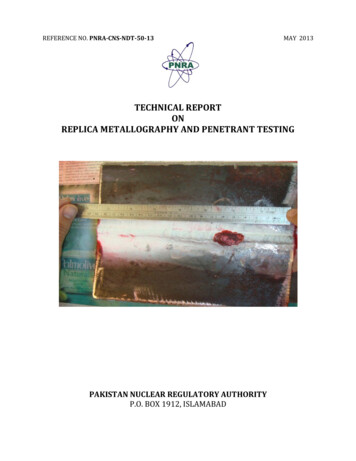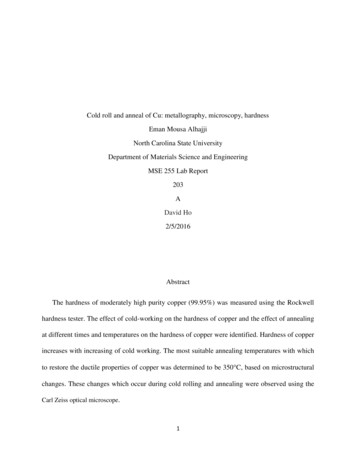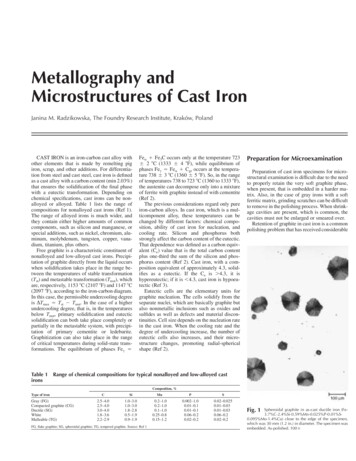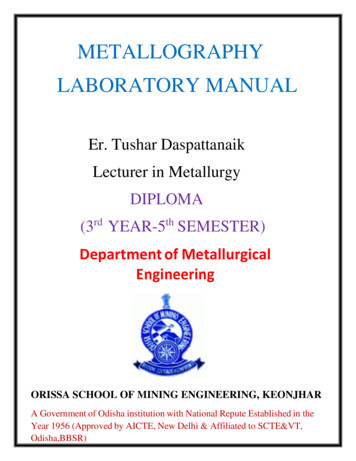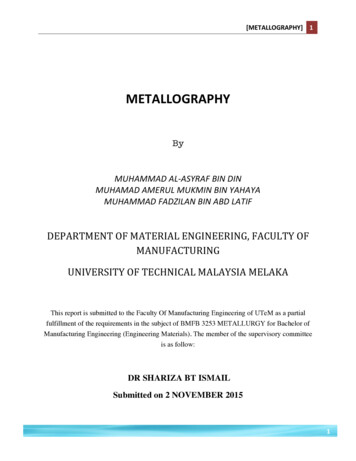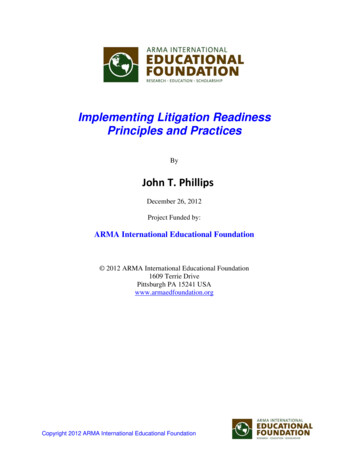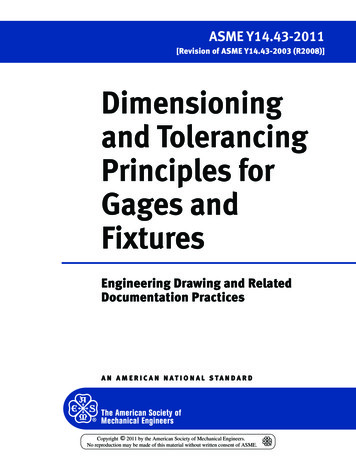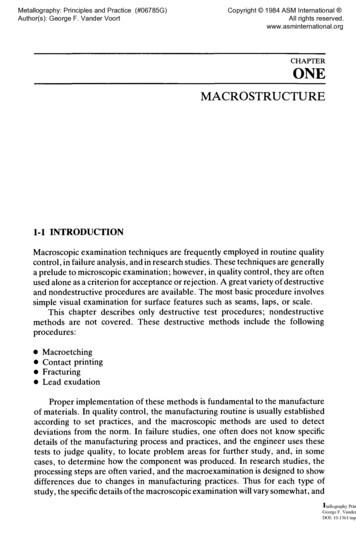
Transcription
Metallography: Principles and Practice (#06785G)Author(s):George F. Vander VoortMetals and PracticeGeorge F. Vander Voort, p 1DOI: 10.1361/mpap191 Copyright 1984 ASM International All rights reserved.Copyright 1999ASM International www.asminternational.orgAll rights UCTURE1-1 INTRODUCTIONMacroscopic examination techniques are frequently employed in routine qualitycontrol, in failure analysis, and in research studies. These techniques are generallya prelude to microscopic examination; however, in quality control, they are oftenused alone as a criterion for acceptance or rejection. A great variety of destructiveand nondestructive procedures are available. The most basic procedure involvessimple visual examination for surface features such as seams, laps, or scale.This chapter describes only destructive test procedures; nondestructivemethods are not covered. These destructive methods include the followingprocedures: MacroetchingContact printingFracturingLead exudationProper implementation of these methods is fundamental to the manufactureof materials. In quality control, the manufacturing routine is usually establishedaccording to set practices, and the macroscopic methods are used to detectdeviations from the norm. In failure studies, one often does not know specificdetails of the manufacturing process and practices, and the engineer uses thesetests to judge quality, to locate problem areas for further study, and, in somecases, to determine how the component was produced. In research studies, theprocessing steps are often varied, and the macroexamination is designed to showdifferences due to changes in manufacturing practices. Thus for each type ofstudy, the specific details of the macroscopic examination willvary somewhat, and1tallography PrinGeorge F. VanderDOI: 10.1361/mpa
Metallography: Principles and Practice (#06785G)Author(s): George F. Vander VoortCopyright 1984 ASM International All rights reserved.www.asminternational.org2 METALLOGRAPHYthe practitioner must have a thorough understanding of the test method, itsapplication, and the interpretation of test data.Interpretation of the data from these tests requires an understanding of themanufacturing process, since the macrostructure is dependent on thesolidification and hot- or cold-working procedures used. There can be pronounced differences in macrostructure because factors such as casting method,ingot size and shape, and chemical analysis will significantly alter the solidification pattern. In addition, the use of manufacturing techniques other thantraditional ingot casting, such as continuous casting, centrifugal casting, electroslag remelting, or hot-isostatic pressing, produce noticeably different as-castpatterns. Also, there is a wide variety of metalworking processes that can beapplied to material made by any of the above processes, and each exerts adifferent effect upon the material. All these factors influence the interpretation ofthe test results.No material can be said to be entirely homogeneous either macroscopically ormicroscopically. The degree of heterogeneity can vary widely depending on thenature of the material, the method of manufacture, and the cost required toproduce the material. Fortunately, the usual degree of heterogeneity is not aserious problem in the use of commercial materials as long as these variances areheld within certain prescribed limits. Certain problems, such as pipe and hydrogen flakes, are in general, quite harmful. The effect of other features, such asporosity, segregation, and inclusions, can be quite difficult to evaluate, and onemust consider the extent of these features, the amount of subsequent metalworking, and the nature of the application of the material.Of the metallographic procedures listed, the macroetch test is probably themost informative, and it is widely used for quality control, failure analysis, andresearch studies. Classification of the features observed with the macroetch test isoften confusing because of the use of "jargon" created since the introduction ofthis test procedure. The macroetch test is covered in considerable detail in thischapter, and numerous examples of its application to a variety of materials arepresented.1-2 VISUALIZATION AND EVALUATION OF MACROSTRUCUREBY ETCHINGAll quality evaluations should begin on the macroscale using tests designed tosurvey the overall field in a simple and reliable manner. After the macrostructureof a material has been evaluated, specific features can then be examined microscopically. Abnormalities observed on the etch disc can be studied by fracturingthe disc or by preparing metallographic polished samples. Macroetching oftransverse or longitudinally oriented samples, i.e., oriented with respect to thehot-working axis, enables the mill metallurgist to evaluate the quality of arelatively large area quickly and efficiently. Thus, macroetching is an extremelypowerful tool and is a cornerstore of the overall quality program.
Metallography: Principles and Practice (#06785G)Author(s): George F. Vander VoortCopyright 1984 ASM International All rights reserved.www.asminternational.orgMACROSTRUCTURE 3The earliest macroetchants were rather weak solutions used at room temperature. Reaumur (1683-1757) used macroetchants to distinguish between differenttypes of steel and sketched the appearance of macroetched pieces of steel in hiswork. Rinmann promoted this technique in his book On the Etching of Iron andSteel, written in the late 1700s. Sorby, in his classic work published in 1887 "Onthe Microscopical Structure of Iron and Steel," showed "nature prints," whichwere inked contact prints of steel etched in moderately strong aqueous nitric acidsolutions [1], The early etching solutions have been reviewed in the classic text byBerglund [2].1-2.1 Macroetching with Acid SolutionsThe first "deep"-etching procedure for steel was developed by Waring andHofamman using nine parts hydrochloric acid, three parts sulfuric acid, and onepart water. Considerable adverse comment about the use of strong acids toevaluate highly stressed components was generated by this paper. Overall, theinitial response to deep-acid etching was negative; however, numerous subsequent studies revealed the great value of such etchants.After the initial work by Waring and Hofamman, considerable attention wasdevoted to the study of strong acids for deep etching steels. The most widely useddeep etch consists of a 1:1 solution of reagent-gradef hydrochloric acid and waterheated to 160 to 180 F for 15 to 45 min. Etching can be conducted on a saw-cutface, but better resolution is obtained with ground faces. Gill and Johnstin foundthat this etch was more selective in its attack than similar solutions involving nitricacid and water or sulfuric acid and water [3]. An important feature of this etchantis that evaporation does not significantly vary its composition during use.The following items should be considered in the development of amacroetchant: The etchant should produce good all-around results, should be applicable to themajority of materials, and should reveal a great variety of structural characteristics and irregularities. The etchant should be simple in composition, inexpensive, and easy to prepare. The etchant should be stable during use or storage. The etchant must be safe to use and should not produce noxious odors.The widespread popularity of the 1:1 hydrochloric acid and water etch is due tothe fact that it satisfies these requirements better than other etchants. Appendix Alists macroetchants for iron and steel as well as for other metals.The 1:1 hydrochloric acid and water etch attacks manganese sulfides readilybut does not attack aluminum oxides. Steels high in aluminum content, such as thenitriding alloys, are etched best with an aqueous solution containing 10% hydrotThe reagent grade contains 36.5 to 38% HO, whereas the technical grade contains 28% HC1
Metallography: Principles and Practice (#06785G)Author(s): George F. Vander VoortCopyright 1984 ASM International All rights reserved.www.asminternational.org4 METALLOGRAPHYchloric acid and 2% nitric acid, developed by V. T. Malcolm. Etching is conductedat 180 F for 15 to 60 min.As the alloy content increases, so does the degree of segregation and itsassociated problems. Etching is pronounced at the segregate-matrix interface,and segregate or matrix areas may etch out, leaving pits. Sulfides or carbides mayalso etch out, leaving pits. Before the investigator can distinguish between pitsdue to nonmetallic inclusions or segregates and carbides, the disc must behardened and reetched. If the pits were due to nonmetallics, they will be presentto the same degree in both the annealed and the hardened discs.Watertown Arsenal [4] developed a variant of the standard etch that consistsof 38 parts of hydrochloric acid, 12 parts sulfuric acid, and 50 parts water.t Thisreagent often produces a sharper definition of features than the standard etch, andlike the standard etch, its acid concentration does not change markedly duringuse.Macroetching provides an overall view of the degree of uniformity of metalsand alloys by revealing: Structural detail resulting from solidification or workingChemical uniformity in qualitative termsPhysical discontinuities due to solidification, working, etc.Weldment structure or heat-affected zones from burning operationsHardness patterns in non-through-hardened steels or patterns due to quenching irregularities Grinding damage Thermal effects due to service abuseThe first three features are best revealed by hot-acid etching, and theremaining four are best revealed by room temperature etchants. Macroetching isusually performed on ground surfaces, although in some cases, especially withcold etchants, better results are obtained when the surface is polished. Chemicalsegregation can be shown by certain cold etchants. The information obtained canbe recorded by photographing the samples or, where possible, by contactprinting.In order to observe these features, one must sample the material properly anduse the macroetch test procedure correctly. Fortunately, these test procedures arestraightforward and simple to use as long as a few precautions are followed. Inpractice, one must consider the following test variables: Selection of representation samplesChoice of surface orientationProper preparation of sample surfaceSelection of the best etch compositionControl of etchant temperature and etch timeDocumentation of test resultstAdd the sulfuric acid slowly to the water and allow it to cool; then add the hydrochloric acid.
Metallography: Principles and Practice (#06785G)Author(s): George F. Vander VoortCopyright 1984 ASM International All rights reserved.www.asminternational.orgMACROSTRUCTURE 5For routine mill inspection, the metallurgist generally cuts a disc from the topand bottom (occasionally the middle) of billets rolled from the first, middle, andlast ingots. For certain products, discs are prepared from all the ingots, afterrolling to the required billet size. These discs should be cut so as not to include anyof the shear drag which may be present after hot shearing the billets to length orremoving the top and bottom discard material. In general, the thickness should beheld to V2 to 1 in, since the weight of larger discs is prohibitive for handling. Bothcuts should be relatively parallel. It is advisable to cut discs with large crosssections into two or more pieces; cutting directly through the center of the discshould be avoided. Transverse discs are used in most cases, although longitudinaldiscs can be useful in evaluating segregation and mechanical heterogeneity. Forroutine work with steels, the saw-cut face is generally satisfactory for etching. Fordetection of fine details, a smooth ground surface is preferred. Some etchantsrequire a smooth ground or a polished surface for proper delineation of macroetchfeatures.It is not necessary to remove the as-rolled scale from the disc, but any grease,dirt, or debris on the cut face should be removed. It is not advisable to hot-acidetch hardened steel discs, since they can crack or fracture during etching.Similarly, billets should be soft prior to cutting to prevent surface damage duringcutting which will obscure the true etch pattern. Proper cutting and grindingtechniques must be employed to avoid any damage from these sources.1-2.2 Copper-Containing Macroetchants for Primary StructureMacroetching steels with etchants containing copper ions predates the development of hot-acid etching. These copper-containing reagents are listed in App. B.Heyn's reagent was the first to be developed; some of the others stemmed fromefforts to produce better results. The reagents are used principally to revealphosphorus or carbon segregation and dendritic structure. At the time thesereagents werefirstintroduced, phosphorus segregation was an important problemin Bessemer steels. Today, however, little Bessemer steel is produced andphosphorus segregation is not a major problem. However, carbon segregation isstill widely evaluated, especially in high-carbon steels. These etchants are employed primarily now in research studies and occasionally in quality control. Oneof the uses of these etchants has been to reveal the primary structure of materials,that is the gross structure resulting from solidification rather than the secondary ortertiary microstructure. More recently developed copper-containing macroetchants have been used to study strain patterns in stressed metals.Stead's no. 1 reagent is one reagent that- has been widely used. Steadrecommended that the etch be used in the following way: A small amount of theetching solution is poured on the surface, and etching is allowed to proceed forabout 1 min. The solution is drained off, and fresh solution is added. This processis repeated until the desired etch pattern is obtained. M
4 METALLOGRAPHY chloric acid and 2% nitric acid, developed by V. T. Malcolm. Etching is conducted at 180 F for 15 to 60 min. As the alloy content increases, so does the degree of segregation and its associated problems. Etching is pronounced at the segregate-matrix interface, and segregate or matrix areas may etch out, leaving pits. Sulfides or carbides may
